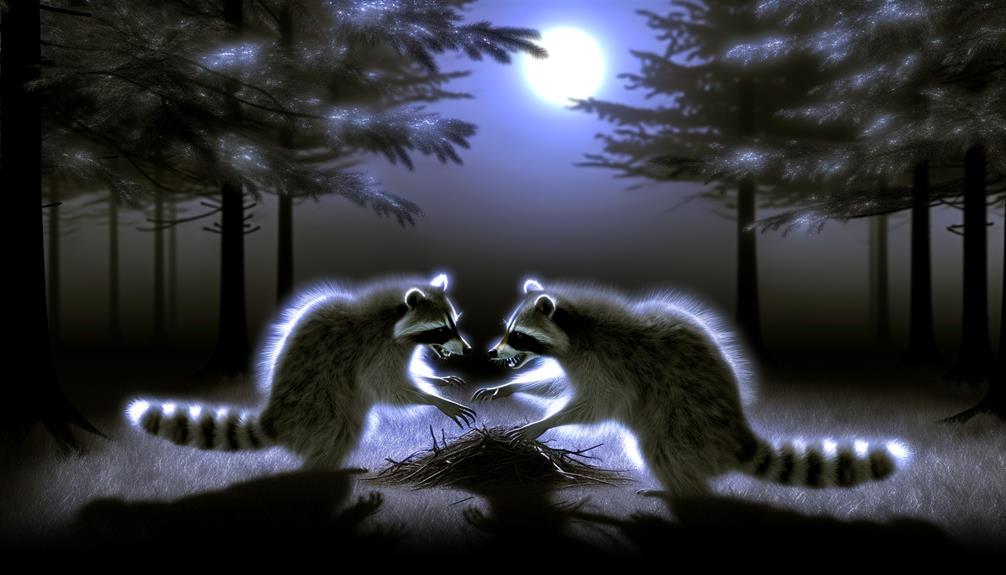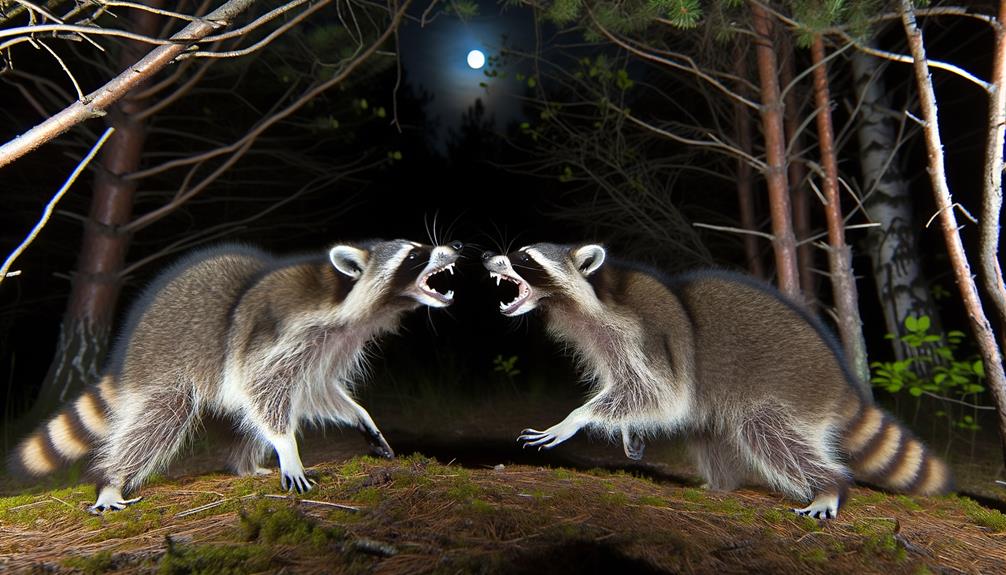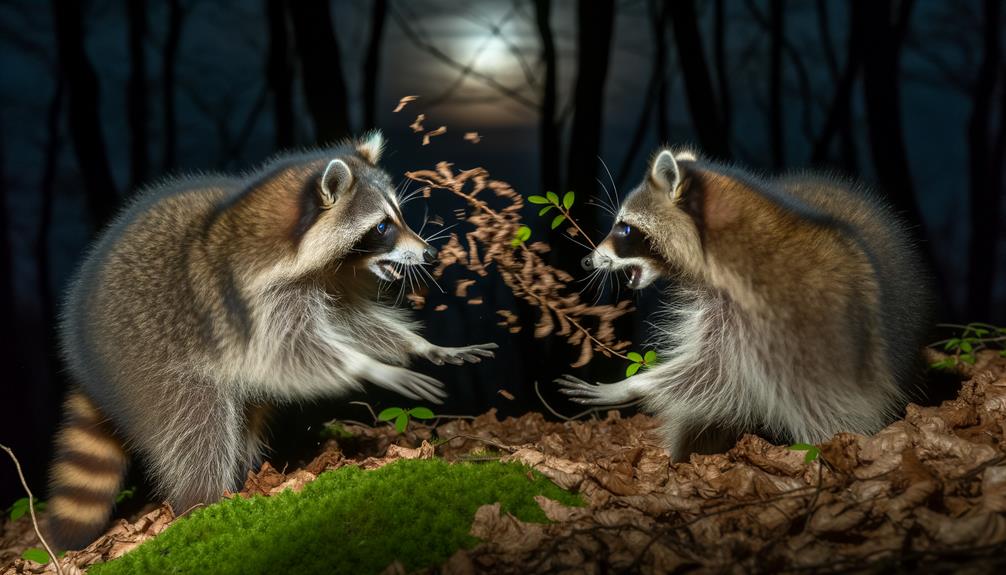Why Do Raccoons Fight Each Other?
Raccoons engage in aggressive behavior primarily during territorial disputes, mating competition, and food scarcity. These confrontations are often triggered by limited resources.
Territorial behaviors are marked by scent marking and vocalizations, escalating to physical fights among raccoons. Male raccoons become particularly aggressive during the mating season as they compete for access to females.
Food scarcity also intensifies aggressive interactions, leading to hierarchical dominance struggles. Defensive behaviors are observed, especially in females protecting their offspring.
These social dynamics and conflict resolution mechanisms, including vocalizations and physical confrontations, are pivotal in maintaining group cohesion. Learn more about the complex social structures of raccoons.

Key Takeaways
- Raccoons engage in aggressive confrontations during territorial disputes, especially in urban environments.
- Male raccoons fight for access to females during the breeding season from January to March.
- Food scarcity triggers increased competition and aggressive behaviors among raccoons.
- Social hierarchies in raccoon populations are established and maintained through physical confrontations and social interactions.
- Female raccoons exhibit heightened aggression to protect their offspring from potential threats.
Territorial Disputes

Territorial disputes among raccoons often arise due to competition for limited resources such as food and shelter. These nocturnal mammals exhibit strong territorial behaviors, particularly in urban environments where resources are concentrated.
Raccoons mark their territories using scent glands and vocalizations, creating a delineated area they defend against intruders. Encounters between raccoons can escalate to aggressive confrontations, involving growling, biting, and clawing. Studies indicate that larger, more dominant raccoons generally secure prime territories, while subordinates are pushed to less desirable areas.
This spatial hierarchy reduces direct conflict but does not eliminate it entirely. Territorial disputes are essential for understanding raccoon behavior, as they influence population dynamics, resource allocation, and the overall health of raccoon communities.
Mating Competition
Mating competition among raccoons is a significant factor influencing their social structure and behavior. During the breeding season, typically from January to March, male raccoons engage in aggressive interactions to secure access to females. These confrontations often involve vocalizations, physical displays, and sometimes violent clashes.
The intensity of these interactions is directly correlated with the availability of receptive females and the density of the raccoon population in the area. Dominant males tend to have higher reproductive success, securing multiple mating opportunities, while subordinate males may be excluded from breeding.
This competitive behavior ensures that the strongest and most adaptable genes are passed on to the next generation, thereby influencing the genetic diversity and fitness of raccoon populations.
Food Scarcity

Food scarcity often triggers aggressive behaviors among raccoons, leading to increased competition for limited resources. This competition can result in hierarchical and dominance struggles, where stronger individuals assert control over food supplies.
Such interactions not only influence individual health and survival but also impact the social structure within raccoon populations.
Competing for Limited Resources
In periods of food scarcity, raccoons frequently engage in aggressive behaviors to secure necessary resources for survival. This aggression typically manifests through physical altercations, vocalizations, and intimidation tactics.
Such behaviors are driven by an instinctual need to prioritize access to limited food sources, which often include fruits, insects, and small vertebrates. The intensity of these interactions can be influenced by various factors, such as the density of the raccoon population within a given area and the availability of alternative food sources.
During these confrontations, raccoons may use their sharp claws and teeth to assert dominance and fend off competitors. These interactions highlight the adaptive strategies raccoons employ to navigate periods of environmental stress and resource scarcity.
Hierarchy and Dominance Struggles
During periods of food scarcity, the establishment of a hierarchical structure among raccoons becomes vital for determining access to limited resources. Dominance hierarchies are typically maintained through aggressive behaviors and physical confrontations.
Higher-ranking raccoons, often characterized by larger size and greater physical strength, secure preferential access to food sources. These dominance struggles help minimize energy expenditure on constant fighting by establishing clear social rankings.
Subordinate raccoons, recognizing their lower status, are less likely to engage in direct confrontations, thereby reducing injury risks. This hierarchical system is essential for the group's overall stability and resource allocation, ensuring that the most dominant individuals, who are often more capable of survival, gain priority access during critical times of scarcity.
Social Hierarchy
Social hierarchy among raccoons is established through a combination of physical confrontations and social interactions, which determine individual dominance and access to resources. Dominant raccoons typically engage in aggressive behaviors to assert authority, while subordinates often display submissive postures to avoid conflict.
This hierarchical structure is fluid, with ranks subject to change based on age, size, and physical condition. High-ranking individuals gain preferential access to food sources and prime denning sites, essential for survival and reproductive success. Social interactions, such as grooming and vocalizations, also play a role in reinforcing these hierarchical relationships.
Understanding raccoon social hierarchy provides insight into their behavioral ecology and the mechanisms driving intraspecific competition and cooperation within their populations.
Defensive Behavior

Raccoons exhibit defensive behavior primarily in the context of territorial disputes, protecting offspring, and competing for resources. These behaviors are critical for their survival and can lead to aggressive encounters with conspecifics.
Understanding these interactions provides insight into the adaptive strategies raccoons use to navigate their environments.
Territorial Disputes
Engaging in territorial disputes is a common behavior among raccoons, driven by their need to protect valuable resources and habitat. These nocturnal mammals exhibit aggressive behaviors to establish dominance and secure access to food, water, and shelter.
Territorial conflicts typically involve vocalizations, such as growls and screeches, as well as physical confrontations. Male raccoons are particularly prone to such conflicts during mating seasons when competition for mates intensifies.
The delineation of territory is often marked by scent marking, using urine or feces to signal occupancy. This defensive behavior ensures that raccoons can maintain a stable living environment, minimizing resource competition and predation risks.
Understanding these dynamics is important for managing raccoon populations in both rural and urban settings.
Protecting Offspring
Maternal raccoons exhibit highly protective behaviors to safeguard their offspring from potential threats. These defensive actions are paramount for the survival of their young, especially given the range of predators and environmental dangers present. When sensing danger, a mother raccoon may employ vocalizations such as growls and screeches to deter intruders. Additionally, physical displays, including aggressive lunges, are common. The following table outlines key defensive behaviors observed in maternal raccoons:
| Behavior | Description | Purpose |
|---|---|---|
| Vocalizations | Growls, screeches | Deter predators |
| Physical Displays | Aggressive lunges | Intimidate intruders |
| Relocation | Moving offspring to safer locations | Avoid detection |
| Concealment | Hiding young in dens or foliage | Protect from predators |
| Surveillance | Continuous monitoring of surroundings | Early threat detection |
These defensive strategies underscore the maternal investment in offspring survival, highlighting the complex social behaviors within raccoon populations.
Resource Competition
Intraspecific competition for resources among raccoons often manifests through defensive behaviors aimed at securing food, territory, and mating opportunities. These behaviors include vocalizations, physical confrontations, and scent marking, which establish dominance hierarchies and reduce direct conflict.
Raccoons display heightened aggression during periods of resource scarcity, such as in urban environments where food sources are limited. Territorial disputes are common, with dominant individuals defending prime foraging and denning areas against intruders.
Mating competition further intensifies aggressive interactions, particularly among males vying for access to receptive females. These defensive behaviors are pivotal for individual survival and reproductive success, shaping the social dynamics within raccoon populations.
Understanding these interactions provides insight into the adaptive strategies raccoons employ to thrive in diverse habitats.
Seasonal Aggression
During certain times of the year, raccoons exhibit heightened aggression due to factors such as mating season and competition for resources. This seasonal aggression is particularly prominent during the spring and fall when the following conditions intensify:
- Mating Season: Male raccoons become significantly more aggressive as they compete for access to females. This often leads to physical confrontations.
- Resource Scarcity: In fall, raccoons aggressively compete for food as they prepare for the winter months.
- Territorial Disputes: Increased movement and activity during these seasons lead to more frequent encounters and territorial conflicts.
- Parental Protection: Female raccoons exhibit heightened aggression when protecting their offspring from potential threats.
These factors collectively contribute to the observed seasonal spikes in raccoon aggression.
Conflict Resolution

Understanding how raccoons resolve conflicts is essential to comprehending their social dynamics, particularly in light of the seasonal aggression previously discussed. Raccoons primarily use a combination of vocalizations, body postures, and sometimes physical confrontations to settle disputes.
Vocal signals such as growls or hisses often serve as warnings, while submissive postures and retreat behaviors are employed to de-escalate tensions. Physical confrontations, though less common, occur when disputes over resources or territory cannot be resolved through vocal or visual cues.
Social hierarchies play a pivotal role, with dominant individuals typically asserting control and subordinates yielding to avoid injury. These conflict resolution mechanisms enable raccoons to maintain group cohesion and reduce the frequency of injurious encounters.
Conclusion
Raccoons engage in intra-species conflict due to various factors such as territorial disputes, mating competition, food scarcity, and social hierarchy. Defensive behavior and seasonal aggression also contribute to these altercations.
While these conflicts may seem chaotic, raccoons exhibit structured mechanisms for conflict resolution to maintain group stability. Such behaviors demonstrate an intricate social dynamic, providing insight into the adaptive strategies of raccoons in response to environmental pressures and internal group interactions.






